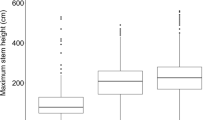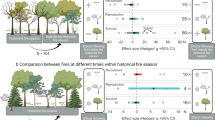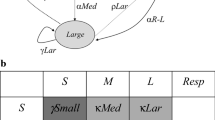Abstract
In grasslands worldwide, modified fire cycles are accelerating herbaceous species extinctions. Fire may avert population declines by increasing survival, reproduction, or both. Survival and growth after fires may be promoted by removal of competitors or biomass and increasing resource availability. Fire-stimulated reproduction may also contribute to population growth through bolstered recruitment. We quantified these influences of fire on population dynamics in Echinacea angustifolia, a perennial forb in North American tallgrass prairie. We first used four datasets, 7–21 years long, to estimate fire’s influences on survival, flowering, and recruitment. We then used matrix projection models to estimate growth rates across several burn frequencies in five populations, each with one to four burns over 15 years. Finally, we estimated the contribution of fire-induced changes in each vital rate to changes in population growth. Population growth rates generally increased with burning. The demographic process underpinning these increases depended on juvenile survival. In populations with high juvenile survival, fire-induced increases in seedling recruitment and juvenile survival enhanced population growth. However, in populations with low juvenile survival, small changes in adult survival drove growth rate changes. Regardless of burn frequencies, our models suggest populations are declining and that recruitment and juvenile survival critically influence population response to fire. However, crucially, increased seedling recruitment only increases population growth rates when enough new recruits reach reproductive maturity. The importance of recruitment and juvenile survival is especially relevant for small populations in fragmented habitats subject to mate-limiting Allee effects and inbreeding depression, which reduce recruitment and survival, respectively.





Similar content being viewed by others
References
Alstad AO, Damschen EI, Givnish TJ, Harrington JA, Leach MK, Rogers DA, Waller DM (2016) The pace of plant community change is accelerating in remnant prairies. Sci Adv 2:e1500975
Borer EB et al (2014) Herbivores and nutrients control grassland plant diversity via light limitation. Nature 508:517–520
Bowles ML, McBride JL, Bell TJ (2015) Long-term processes affecting restoration and viability of the federal threatened Mead’s milkweed (Asclepias meadii). Ecosphere 6:1–22
Bürkner P (2017) brms: An R package for Bayesian multilevel models using Stan. J Stat Softw 80:1–28
Caswell H (2001) Matrix population models, 2nd edn. Sinauer Associates Inc, Sunderland
Caswell H, Fujiwara M (2004) Beyond survival estimation: mark-recapture, matrix population models, and population dynamics. Anim Biodivers Conserv 27:471–488
Caswell H, Kaye TN (2001) Stochastic demography and conservation of an endangered perennial plant (Lomatium bradshawii) in a dynamic fire regime. Adv Ecol Res 32:1–47
Collins SL, Knapp AK, Biggs JM, Blair JM, Steinauer EM (1998) Modulation of diversity by grazing and mowing in tallgrass prairie. Science 280(5364):745–747
Davison R, Jacquemyn H, Adriaens D, Honnay O, de Kroon H, Tuljapurkar S (2010) Demographic effects of extreme weather events on a short-lived calcareous grassland species: stochastic life table response experiments. J Ecol 98:255–267
de Kroon H, Plaisier A, van Groenendael J, Caswell H (1986) Elasticity: the relative contribution of demographic parameters to population growth rate. Ecology 67:1427–1431
Dornelas M (2010) Disturbance and change in biodiversity. Phil Trans R Soc B 365:3719–3727
Dykstra AB (2013) Seedling recruitment in fragmented populations of Echinacea angustifolia. PhD dissertation, Plant Biological Sciences, University of Minnesota, St. Paul, Minnesota, USA
Franceschinelli EV, Bawa KS (2005) The post-fire effects on the outcrossing rate of a Brazilian savannah shrub, Helicteres sacarolha A.St.-Hil. Braz J Bot 28:163–170
Franco M, Silvertown J (2004) A comparative demography of plants based upon elasticities of vital rates. Ecology 85:531–538
Gage AM, Olimb SK, Nelson J (2016) Plowprint: tracking cumulative cropland expansion to target grassland conservation. Gt Plains Res 26:107–116
García MB, Picó FX, Ehrlén J (2008) Life span correlates with population dynamics in perennial herbaceous plants. Am J Bot 95:258–262
Gelman A, Hill J (2007) Data analysis using regression and multilevel/hierarchical models, 1st edn. Cambridge Univ. Press, Cambridge, UK
Goldberg DE, Gross KL (1988) Disturbance regimes of midsuccessional old fields. Ecology 69:1677–1688
Goldberg DE, Werner PA (1983) The effects of size of opening in vegetation and litter cover on seedling establishment of goldenrods (Solidago spp.). Oecologia 60:149–155
Haddad NM et al (2015) Habitat fragmentation and its lasting impact on Earth’s ecosystems. Sci Adv 1:e1500052
Hoekstra JM, Boucher TM, Ricketts TH, Roberts C (2005) Confronting a biome crisis: global disparities of habitat loss and protection. Ecol Lett 8:23–29
Hulbert LC (1988) Causes of fire effects in tallgrass prairie. Ecology 69:46–58
Hurlburt DP (1999) Population ecology and economic botany of Echinacea angustifolia: a native prairie medicinal plant. PhD dissertation, Ecology and Evolutionary Biology, University of Kansas, Lawrence, Kansas, USA
Ison JL, Wagenius S, Reitz D, Ashley MV (2014) Mating between Echinacea angustifolia (Asteraceae) individuals increases with their flowering synchrony and spatial proximity. Am J Bot 101:180–189
Jutila HM, Grace JB (2002) Effects of disturbance on germination and seedling establishment in a coastal prairie grassland: a test of the competitive release hypothesis. J Ecol 90:291–302
Kaye TN, Pendergrass KL, Finley K, Kauffman JB (2001) The effect of fire on the population viability of an endangered prairie plant. Ecol Appl 11:1366–1380
Kimmerer RW, Lake F (2001) The role of indigenous burning in land management. J For 99(11):36–41
Knapp AK, Seastedt TR (1986) Detritus accumulation limits productivity of tallgrass prairie. Bioscience 36:662–668
Lamont BB, Downes KS (2011) Fire-stimulated flowering among resprouters and geophytes in Australia and South Africa. Plant Ecol 212:2111–2125
Leach MK, Givnish TJ (1996) Ecological determinants of species loss in remnant prairies. Science 273:1555–1558
Levin L, Caswell H, Bridges T, DiBacco C, Cabrera C, Plaia C (1996) Demographic responses of estuarine polychaetes to pollutants: life table response experiments. Ecol Appl 6:1295–1313
Levin DA, Kelley CD, Sarkar S (2009) Enhancement of allee effects in plants due to self-incompatibility alleles. J Ecol 97:518–527
Louthan AM, Pringle RM, Goheen JR, Palmer TM, Morris WF, Doak DF (2018) Aridity weakens population-level effects of multiple species interactions on Hibiscus meyeri. PNAS 115:543–548
Lunt ID (1994) Variation in flower production of nine grassland species with time since fire, and implications for grassland management and restoration. Pac Conserv Biol 1:359–366
Lunt ID, Morgan JW (2002) The role of fire regimes in temperate lowland grasslands of southeastern Australia. In: Bradstock RA, Williams JE, Gill MA (eds) Flammable Australia: the fire regimes and biodiversity of a continent. Cambridge University Press, Cambidge, UK, pp 177–191
Mannouris C, Byers DL (2013) The impact of habitat fragmentation on fitness-related traits in a native prairie plant, Chamaecrista fasciculata (Fabaceae). Biol J Linn Soc 108:55–67
Menges ES (1991) Seed germination percentage increases with population size in a fragmented prairie species. Conserv Biol 5:158–164
Menges ES, Dolan RW (1998) Demographic viability of populations of Silene regia in midwestern prairies: relationships with fire management, genetic variation, geographic location, population size and isolation. J Ecol 86:63–78
Menges ES, Kimmich J (1996) Microhabitat and time-since-fire: effects on demography of Eryngium cuneifolium (Apiaceae), a Florida scrub endemic plant. Am J Bot 83:185–191
Mola JM, Williams NM (2018) Fire-induced change in floral abundance, density and phenology benefits bumblebee foragers. Ecosphere 9:e02056
Morgan JW (1998) Importance of canopy gaps for recruitment of some forbs in Themeda triandra-dominated grasslands in south-eastern Australia. Aust J Bot 46:609–627
Morgan JW (2001) Seedling recruitment patterns over 4 years in an Australian perennial grassland community with different fire histories. J Ecol 89:908–919
Morgan JW, Meyer MJ, Young AG (2013) Severe habitat fragmentation leads to declines in genetic variation, mate availability, and reproductive success in small populations of a once-common Australian grassland daisy. Int J Plant Sci 174:1209–1218
Münzbergová Z, Herben T (2005) Seed dispersal, microsite, habitat and recruitment limitation: identification of terms and concepts in studies of limitations. Oecologia 145:1–8
R Core Team (2018) R: a language and environment for statistical computing. R Foundation for Statistical Computing.
Stan Development Team (2018) Rstan: the R interface to Stan. R package version 2.17.13. http://mc-stan.org
Supp SR, Ernest SKM (2014) Species-level and community-level responses to disturbance: a cross-community analysis. Ecology 95:1717–1723
Umbanhower CE (1996) Recent fire history of the northern Great Plains. Am Midl Nat 135:115–121
Van Nuland ME et al (2013) Fire promotes pollinator visitation: implications for ameliorating declines of pollinator services. PLoS ONE 8:e79853
Vehtari A, Gelman A, Gabry J (2017) Practical Bayesian model evaluation using leave-one-out cross-validation and WAIC. Stat Comput 27:1413–1432
Veldman JW et al (2015) Toward an old-growth concept for grasslands, savannas, and woodlands. Front Ecol Env 13:154–162
Waananen A, Kiefer G, Ison JL, Wagenius S (2018) Mating opportunity increases synchrony of flowering among years more than synchrony within years in a nonmasting perennial. Am Nat 192:379–388
Wagenius S, Lonsdorf E, Neuhauser C (2007) Patch aging and the S-Allee effect: breeding system effects on the demographic effects of plants to habitat fragmentation. Am Nat 169(3):383–397
Wagenius S, Hangelbroek HH, Ridley CE, Shaw RG (2010) Biparental inbreeding and interremnant mating in a perennial prairie plant: fitness consequences for progeny in their first eight years. Evolution 64:761–771
Wagenius S, Dykstra AB, Ridley CE, Shaw RG (2012) Seedling recruitment in the long-lived perennial, Echinacea angustifolia: a 10-year experiment. Restor Ecol 20:352–359
Wagenius S, Beck J, Kiefer G (2020) Fire synchronizes flowering and boosts reproduction in a widespread but declining prairie species. PNAS 117:3000–3005
Warner RR, Chesson PL (1985) Coexistence mediated by recruitment fluctuations: a field guide to the storage effect. Am Nat 125:769–787
White R, Murray S, Rohweder M (2000) Pilot analysis of global ecosystems: grassland systems. World Resources Institute, Washington, DC, USA
Acknowledgements
We express gratitude to Gretel Kiefer, Amy Waananen, and Will Reed for assisting in organizing seedling and demographic data as well as members of Team Echinacea, 1999–2016, for assisting in collecting all field data. Additionally, we thank Ruth Shaw, Daniel Doak, and Jared Beck for providing feedback on modeling and early versions of the manuscript. We finally thank land owners and agency employees for granting access to sites and Troy Boschee for providing information about burns. The Echinacea project has been supported by the NSF including awards 1557075, 1355187, 1052165, 1051791, 0545072, 0544970, and 0083468. SWN was also supported by NSF IGERT award 114807.
Author information
Authors and Affiliations
Contributions
SW and ABD planned and executed data collection. SW and SWN conceived project idea. SWN and ABD organized and prepared data. SWN designed methods, analyzed data, and wrote the first draft of the manuscript. All authors contributed substantially to subsequent editing and revision of manuscript and figures.
Corresponding author
Ethics declarations
Conflict of interest
The authors declare no conflicts of interest.
Data archiving
We have archived all data and scripts to reproduce analysis and figures on the Echinacea Project website at http://echinaceaproject.org/datasets/nordstrom-fire-demography-2020/.
Additional information
Communicated by Brian J. Wilsey.
This manuscript uses sophisticated quantitative techniques to highlight context dependence in which demographic processes contribute to population growth of a grassland forb after fires.
Supplementary Information
Below is the link to the electronic supplementary material.
Rights and permissions
About this article
Cite this article
Nordstrom, S.W., Dykstra, A.B. & Wagenius, S. Fires slow population declines of a long-lived prairie plant through multiple vital rates. Oecologia 196, 679–691 (2021). https://doi.org/10.1007/s00442-021-04955-2
Received:
Accepted:
Published:
Issue Date:
DOI: https://doi.org/10.1007/s00442-021-04955-2




